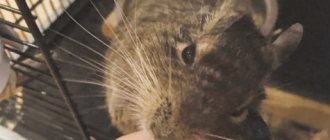It is easier to tame a chinchilla than any other rodent. The chinchilla itself is very sociable and friendly with those who properly care for it and respect it. A chinchilla can be tamed very quickly if it is not yet an adult, but an adult can also be tamed, but it will take a little longer.
Many people have the problem that the chinchilla bites; most often this happens due to improper taming, when the animal does not completely trust you. Therefore, it is important to read how to properly tame and hold a chinchilla in your hands so that it does not bite you or let out a stream of urine.
Is it possible to train a chinchilla to handle your hands?
The success of taming an animal largely depends on its character, origin, age, gender, attitude of the previous owner (if there was one) and even the animal’s lifestyle.
For example, adult individuals that come to humans directly from wild conditions are difficult to domesticate. Such rodents are accustomed to fighting for existence in rather harsh conditions and trust only their instincts. But if a pet was born at home and from the first days of life it observed a person next to it, such an animal is much easier to accustom to hands. It's even better when the chinchilla's parents were also born and raised at home by a human.
What matters is how people cared for and interacted with the animal. It’s not enough to just throw food into the cage and clean it occasionally. In order for the animal to trust the hands of a person, it is necessary to establish tactile contact with it in advance. Of course, this contact should be soft, pleasant for the rodent, and not cause fear and rejection.
It has been proven that it is easier to handle a chinchilla that lives alone in a cage. Such an animal is more willing to communicate with another living being (in this case, a person). But rodents living together are quite self-sufficient, and it will take more effort to tame them. In general, loners communicate better with people and enjoy food and affection.
It is believed that males are more amenable to taming. This is partly due to the physiological characteristics of females: every 1.5 months for 2-7 days they experience estrus, and therefore they are nervous, sometimes even aggressive. However, if you patiently and carefully care for your female chinchilla, you will eventually be able to make her completely tame. Although males are still much more friendly towards people.
Practice shows that young chinchillas, and especially those on artificial feeding, get used to people faster and are more willing to be held.
Features of care: how to equip the cage
Keeping chinchillas, according to many pet lovers, is not at all difficult. In order for an animal in the family to feel as comfortable as possible, its owners first of all, of course, need to properly equip its cage.
In addition to bowls for food and water, two more items should be installed in the chinchilla’s “house”:
- wheel;
- tray.
The wheel will be very good entertainment for the chinchilla. Of course, not every owner will decide to let an animal wander around the house. After all, chinchillas are nimble creatures and can easily escape either through the front door or into the cracks between the structures of the house. Active movement is very useful for such rodents, like any other.
The question of how to accustom a chinchilla to a wheel will most likely not arise at all for its owners. Most of these animals immediately climb into such a device and begin to actively run in it. True, there are also animals that wait for some time and prefer to first make sure that the new object that appears in the cage is harmless. There is also a small category of chinchillas that do not recognize wheels at all. In any case, it is unlikely that the owners will be able to train such an animal to “play sports.”
First steps
To successfully tame an animal, you need to choose the right strategy. In the very first days of meeting an animal, you should not try to actively caress and stroke it. It is quite possible that the chinchilla will be uncomfortable with your touch, simply due to fright and the stress experienced from “moving”. Moreover, be prepared for the fact that the animal will try to bite you or stain you with a stream of urine (this is a common method of self-defense among animals).
Therefore, in the first days you need to give the rodent the opportunity to calm down, get acquainted with the situation and, as they say, get bored with communication. During this period, it is advisable to exclude rude actions, sharp sounds, and frequent turning on and off of lights. You cannot scare the animal, otherwise it will be difficult to tame it - the adaptation period will take too long.
Once your pet gets used to your home, you will see that it will be easier to establish the first contact.
Precautions and safety precautions
After the animal has been tamed, it is necessary to take care of its safety. Thanks to his natural curiosity, he begins to be interested in everything that surrounds him. Chinchillas are cunning and agile. They can jump up sharply and quickly run away. Therefore, windows and doors should not be left open. Before releasing the animal from the cage, you need to remove all breakable objects from the room. You should also cover the wires to prevent him from chewing on them. The animal may chew buttons on the owner's clothes. At first, it is not advisable for the rodent to be in the same room with other animals.
How to tame a young chinchilla?
Young chinchillas are known to get used to human hands more easily. They are quite curious and sociable, and you can use various tricks to lure the animal to you. However, young individuals are often very timid, and you need to be especially careful in approaching them, without making any sudden movements.
Standard algorithm for taming a young chinchilla:
- We begin to slowly and without sudden movements approach the cage with the pet, speak quietly and calmly to it, call it by name (at first the animal will be scared, and this is normal);
- when the chinchilla gets used to your approach (doesn’t squeeze into a corner or hide in the house), you can try to smoothly open the door (make sure that the animal doesn’t get scared);
- after a couple of days, you can serve the treat by hand, hold the treat in your palm, and place it in the cage;
- within 1-2 weeks the chinchilla will become bolder and will take food directly from the palm of your hand;
- try to carefully pick up the animal, but under no circumstances grab it by the scruff of the neck (this means an attack);
- let your pet crawl along your arms and climb onto your shoulders.
For a young chinchilla, it is important to choose the “right” name. It should not be too long or, conversely, short. It is desirable that it contains soft hissing sounds. In order for the animal to get used to its name and begin to respond, always say it when approaching the cage, as well as when giving treats and in the process of accustoming it to your hands.
Experienced breeders, along with the name, use additional accent sounds that attract the animal’s attention and prepare it for the upcoming communication with the owner. For example, you can click your tongue slightly when you approach the cage and bring a treat.
What to do after purchase
Experienced pet lovers do not recommend trying to tame a chinchilla immediately after it is in the house. At this time, such an enterprise is unlikely to be successful. Finding itself in a place unfamiliar to it, the chinchilla will experience fear. And to overcome a stressful situation, she will probably need a little time.
The purchased chinchilla will need to be placed in a cage prepared in advance for it and left alone. Of course, you should first place a box of food and a bowl of water in the animal’s “house”.
How to accustom an adult chinchilla to being held?
Adult chinchillas are undoubtedly more careful and careful in their interactions. It can be especially difficult to tame rodents that have changed owners, and the previous owner did not train the animal or made critical mistakes in caring for it. In general, when taking an adult animal from its previous home, you should ask why the owner decided to part with the pet. Perhaps the chinchilla was not in the best conditions. Then it will not be easy to regain her trust in people.
Animals that are already accustomed to humans, know how to communicate with them, and are not afraid to take food from people are well tamed. Even if such a rodent has never sat in your arms, it is likely that you will be able to tame it. Although in this case you will need patience and endurance. In general, all chinchillas are determined to communicate; it is extremely rare to encounter individuals who completely ignore communication.
And yet, to tame an adult animal, you will have to spend much more time than in the case of a young pet.
The process of taming an adult chinchilla is as follows:
- in the first days we leave the animal alone - let it get used to the new conditions (it is advisable to make a house in the cage where the animal will hide when it is scared);
- in the evening you can carefully approach the cage, sit at a distance and speak in a calm, even voice, using the chinchilla’s name (it is better not to change the nickname);
- gradually open the door, serve the goodies in the palm of your hand (you need to repeat the action for several days until the animal gets used to it);
- when the chinchilla gets completely comfortable, he will begin to take food from the palm of his hand - place it further and further, inviting the pet into your hand;
- hold the animal in your arms, let's run on the shoulders and enjoy the process.
As with a young animal, an adult chinchilla should be given time to adapt. Moreover, the more time passes from the moment of “moving”, the more effective your attempts to establish close contact will be. If you rush into communication, you can get aggression in response, and then the taming process will drag on for an indefinite period of time.
All chinchillas are very inquisitive animals. Take advantage of this by letting the animal decide for itself when it first climbs into your arms.
Where to start getting acquainted?
Most new rodent owners believe that immediately after purchasing an animal they can hug and pet it. This is absolutely not true - a chinchilla that is not familiar with a person will be scared and may show aggression - this is expressed in biting or in releasing a stream of urine on the “enemy”, which at the moment is a person.
A bottle-fed chinchilla gets used to humans faster
In the first days after acquiring a pet, you should not disturb him too much - let him get comfortable in his new home and visually get to know the family members. Do not scare your pet under any circumstances, otherwise the taming process will take a long time. Chinchillas are very afraid of loud sounds and rough actions - all this should be avoided.
Why should you get a chinchilla?
These rodents, native to South America, reach a size of 40 centimeters with a tail length of up to 70 centimeters. Chinchillas have taken a strong place among pets. Why are they so attractive?
- It cannot be denied that the chinchilla has a pleasant and pretty appearance, which is an undoubted advantage.
- These rodents do not emit an unpleasant odor.
- Chinchillas are suitable for people suffering from allergic reactions. The fur and secretions of these animals are harmless and do not cause allergies.
- They do not need to be vaccinated; in general, these rodents hardly suffer from any diseases.
- Chinchillas tolerate loneliness well, which is a plus for busy and working owners. These rodents can be left to their own devices all day long, provided there is food and water in the cage.
- Chinchillas are completely non-aggressive and can be tamed.
The contact of these animals depends on the following factors.
- The place where they were born. If a chinchilla came from already domesticated parents, then it will trust a person, which means it will be easy to interact with him.
- Tactile contact. If the breeders communicated with the animal from the first days of life, and did not just feed and clean up after it, then it will be easier for the new owner to establish a connection with the chinchilla.
- Content. As a rule, single chinchillas are more willing to make contact with humans than those kept in a cage in pairs or entire groups.
- Floor . Males are usually more susceptible to training and taming, but with the right approach, you can also find a common language with females.
Selection of combs
When figuring out how to comb your furry pet, you need to understand that a regular comb for humans is not suitable for chinchillas, just like tools for dogs.
Experienced chinchilla breeders recommend considering some cat models if local pet stores carry specialized rodent products. The fur of the animal is very soft and thick. Up to 80 hairs can grow from one hair follicle, so the main criteria that a chinchilla comb must meet are the following:
- free penetration into the thickness of the hair;
- no “slicker” effect: such a device will remove not only dead, but also living hair, causing pain;
- the presence of long and thin teeth;
- purchased point so as not to harm the skin.
The animal needs a set of combs with different teeth
How to tame a young animal?
The small chinchilla is quite timid, so taming should be gradual and careful so that the animal is not stressed. How to tame a chinchilla at a young age?
- It is important to speak kindly to the rodent and often flash before its eyes so that the chinchilla gets used to its owner. But when communicating, you should keep your distance - do not put your face too close to the rodent and do not touch it with your hands.
- You need to approach your pet at a quiet and slow pace; sudden movements and noise can frighten the chinchilla.
- At first the animal will behave fearfully. But when he stops hiding, you can try to open the cage door, the movements should be smooth and careful.
- No taming is complete without treats. Therefore, after 3-4 days, you can give the little chinchilla some tasty treat by opening your palm.
- After 7 (sometimes 14) days, the chinchilla will take treats from your hands. And only after that you can try to pet her and pick her up.
- Some owners make a certain sound (for example, clicking) before approaching the cage. After some time, the chinchilla associates this sound with the owner approaching it, which means there will be games or treats ahead.
Usually rodents at a young age easily make contact with a new owner. The main thing is to be patient and not to frighten the animal with excessive assertiveness.
First contact
The first touches should take place during feeding with treats, because in normal times you will easily scare her and consider that the first two stages will go to waste, you will have to start all over again.
It is recommended to gently stroke your chinchilla's neck when you palm feed it. This must be done simultaneously. For example, we put a treat in our hand, and with our index finger we begin to stroke her face with smooth movements, preferably stroking the area of her neck under her ear.
If the chinchilla is already quite accustomed to you, then she will not be afraid of such light stroking. If she gets scared, just continue feeding her treats for a couple more days, and then try petting her again.
I think that the first contact is the most important, because the chinchilla has already begun to trust you and stops hiding every time you open the cage. Her behavior reinforces that opening the cage and your hand means a portion of delicious food.
The animal may accidentally bite you, but you must endure it and not make any sudden movements; after frightening the animal, it may not approach you again for several days. You can scold and punish only tamed adults who, for some reason, began to play pranks, but you cannot scold young individuals, because trust has not yet been formed between you.
The end of the initial contact stage can be considered when the chinchilla has changed in behavior in such a way that you clearly notice it. She is not frightened by your movements, she easily allows herself to be petted and eats treats near you, rather than dragging them away somewhere.
How to tame an adult chinchilla?
It happens that for various reasons people acquire an adult rodent, and here the process of domestication depends on many factors: in what conditions it was kept before, whether it had contact with people, whether it is scared or not. An older pet requires a special approach, sometimes even a long one. But you can still train an adult to be held in your arms. What do we have to do?
- There is no need to start the taming process right away. It is better to let the chinchilla get used to the new place, atmosphere and smell. This may take a couple of days.
- To make a chinchilla feel safe in a cage, it is better to provide it with a special house where it can hide.
- Communication with the owner is an important stage of taming. But the intonation should be calm, even, affectionate. If the animal does not look scared and is not hiding, then you can proceed to further actions.
- You should give the chinchilla a tasty treat and try to pet it. After some time, the rodent will become tame.
- The name of an adult chinchilla should not be changed if it has already been named somehow by its previous owners. This will make it easier for the animal to adapt to a new environment and make friends with the new owner.
The process of accustoming an adult chinchilla to being handled will be more difficult than a young one. Nevertheless, with the help of affection and attention, you can achieve the location and trust of your furry pet.
Expert advice on feeding
So, we found out how to accustom a chinchilla to the tray and hands. But what kind of food should be offered to such an animal? Chinchillas are most often fed a specially purchased grain mixture. The composition of such products, in addition to cereal seeds, usually includes dried vegetables, fruits, and pressed herbs. Sometimes manufacturers even add a little popcorn to this food.
Chinchillas are usually given fruits, vegetables, and tree branches from their natural food. You can also offer the animals carrot tops, clover, and dandelions. In winter, chinchillas willingly eat grass hay. The most suitable grains for such animals are oats, barley, corn and wheat.
How to properly pet a chinchilla?
It seems that all animals love stroking, but it is not so easy to touch a chinchilla if it is scared and distrustful. You can get an aggressive reaction in response, even a bite. Therefore, if the owner wants to pet a new furry friend, then the following rules should be followed.
- At the moment when the rodent accepts a treat from your hand, you can try to touch its chin to scratch it. It may not work out the first time, but you shouldn’t stop trying; the main thing is to act gradually and not forcefully.
- After the chinchilla has climbed into your palm for a treat, there is no need to remove your hand. Let the rodent sit for a while, so it will become more accustomed to its owner. If the animal immediately jumps from the palm of your hand when it takes the treat, there is nothing to worry about. Sooner or later the chinchilla will get used to your hands.
- If the owner opens the cage, the animal may already meet him and climb into the palm of his hand. Then you can pet your pet using your index finger. You should carefully rub along the chinchilla's cheeks and chin, trying not to touch the antennae (sensitive area). If the rodent runs away, don’t worry; when it returns, you can repeat the same steps.
- If the animal does not resist stroking its muzzle, you can use your other hand to stroke its back. These actions may make the rodent nervous at first; you should give him time to get used to it and repeat the actions the next day.
- It is important not to swing your palm over the chinchilla, because the rodent associates such an action with an attack by a predator. The same goes for grabbing the scruff of the neck. Such movements can not only fail to earn your pet’s trust, but also truly frighten him.
It is important to be affectionate and careful, then the animal will feel safe and will easily make contact.
They bite: is this normal?
It is normal for animals to be distrustful of changes in surroundings or new things. Most often this is a change in diet, new place of residence, accessories or attitude towards the chinchilla. They may bite when scared or nervous. First you need to give time to get comfortable in your new home and get used to the surroundings.
If the pet feels safe, then it should not bite. To do this, provide your pet with:
- spacious cage;
- the absence of a large number of strangers;
- cozy atmosphere.
Let's look at the reasons why a chinchilla might bite.
Meet the owner
To evaluate a chinchilla, just watch its behavior or stroke it. The pet also evaluates the owner. Like many animals, the chinchilla is guided by sensations and reflexes. The animal tries to bite the skin on the palm, arm and leg, assessing the person.
Accident
A chinchilla does not always set the goal of biting; it often happens by accident. Sometimes, while testing the owner's things, she may accidentally bite an arm or leg. Also, when feeding, he sometimes accidentally bites his finger.
Shows dissatisfaction
Trying to hold a pet against its will, giving it food it doesn't like, or cleaning its cage while the pet is sleeping.
These moments are manifested in the animal by dissatisfaction, as a result of which the chinchilla bites fingers, hands and everything it reaches, making it possible to understand that it is uncomfortable.
Aggression
Sometimes, a chinchilla exhibits aggressive behavior towards humans. Most often this happens when the pet does not have complete trust in the person, when the owner does annoying things or causes pain. For example, when trying to wash a chinchilla’s eyes or perform other medical procedures, the animal can bite very painfully.
Poor living conditions or illness
Also the main factor influencing the behavior of a chinchilla. When she is uncomfortable, hungry, sick or not feeling well, she will not be kind to the person.
Mating season
In this situation, a chinchilla is able to bite because it is excited, active, ready to fight for its soul mate and does not notice obstacles in its path.
It can be either a male who protects his female or an irritable female.
The last reason for a pet’s unwanted behavior is harmfulness. Oddly enough, chinchillas often bite at home simply because they feel like it.
They don't want to see you or don't understand how to behave differently. In such cases, you need to wean the animal from doing this.
Safe reasons for biting
Most often this is mutual grooming. If you begin to carefully sort out the fur under the chin and on the chest of your chinchilla with your fingers, then most likely in response she will begin to bite your fingers a little. Therefore, it is better to buy a couple of pets; they will look after each other themselves. If there is only one animal, monitor the condition of its fur and, if necessary, carefully comb it.
How to train and tame a chinchilla to your hands, tray, name
Chinchillas are considered to be decorative animals. And even though they have been kept at home for more than a century, many still have questions about how to tame them. The natural distrust of these animals towards humans can be easily overcome if you show a little patience and attention. In this article we will focus on the main points of adaptation and training of chinchillas, which everyone who wants to buy this animal as a pet needs to know.
Is it possible to iron
If the owners approach the matter correctly, the chinchilla in their arms will subsequently feel comfortable and calm. The fur of these animals is so soft, “plush” and delicate that, judging by the reviews of the owners of such rodents, it is a pleasure to touch it. Therefore, many owners of such animals constantly pick them up, stroke them on the head and scratch them behind the ears. In principle, this can be done. Chinchillas are not fragile animals, they are healthy and quite hardy.
However, stroking such animals, unfortunately, in most cases only brings pleasure to their owners. From such actions of the owners, the chinchillas themselves are, as they say, neither warm nor cold. Such animals do not consider stroking as a sign of attention from the owner, but mainly only the high-quality, tasty food offered to them.
Despite the fact that chinchillas, unlike cats and dogs, always remain indifferent to the owner’s “tenderness,” such animals are able to understand the intonations of the owner’s voice very well. Therefore, when taming a pet and subsequently communicating with it, its owners should speak in a soothing, gentle voice. The chinchilla will most likely appreciate this and will soon begin to completely trust the people living in the house.
The intelligence of a furry animal
Most chinchilla owners admit that they are quite smart animals with developed intelligence. However, in terms of their mental abilities, they are significantly inferior to dogs and very slightly to cats. Moreover, chinchillas are smarter than rabbits and rats. They have well-developed hearing and sense of smell.
Before you begin training, you should observe the rodent, examine its character and temperament. These furry animals, like people, differ from each other: among them there are choleric, sanguine, phlegmatic and melancholic.
Sanguine people are the most amenable to training - they quickly develop positive and negative reflexes. Cholerics appreciate positive signals and react poorly to negative ones. Phlegmatic people learn longer than others, but their skills are better reinforced. The most difficult thing to work with is a melancholic chinchilla.
Intellectual abilities
Chinchillas are not like their rodent counterparts: they are smarter and smarter. In a sense, they can be compared to a cat. Since this animal has excellent eyesight, it is able to distinguish many colors and see well.
A well-developed sense of smell and acute hearing provide an excellent opportunity to explore the world. And for their owners, this is an opportunity to teach their pets commands that will help them adapt to a new place.
Training chinchillas is good primarily for establishing a bond between the owner and the pet. Breeders who have been breeding chinchillas for a long time will tell you that their animals recognize them by smell, hearing and remember their appearance. They answer to their name. While walking around the apartment, chinchillas learn to open cabinet doors, use doorknobs, can climb into hard-to-reach places and press computer buttons.
How to tame a chinchilla
Taming a chinchilla is a long and laborious process. But after going through this difficult path, you will get real joy from communicating with a cute furry animal. Many people initially make irreparable mistakes without learning the basic rules of taming.
To the hands
Early taming of a chinchilla is a guarantee of successful communication with your pet. It is also possible to train an adult rodent, although it will require more effort.
Follow these simple guidelines:
- Always feed your pet treats directly from your hands, rather than pushing them through the bars of a cage (or display case).
- Periodically place your hands under your pet's nose. Give it a sniff and watch his reaction. The animal should show interest, perhaps even trying to climb into your arms. If the pet is afraid, bites or moves your hand away, do not insist, try again the next day. Accompany the taming process with hand feeding. Eventually the chinchilla will give in and climb into your arms.
- Once the animal gets used to your hands, you can help him climb onto them by gently moving him with a second handle or placing a hand under his tummy.
- As soon as the rodent is in your arms of its own free will, immediately reinforce its action with positive reinforcement (scratch the animal, then treat it to your favorite food).
To the tray
Chinchillas have a habit of leaving excrement all over their cage. To prevent this from happening, try to accustom the animal to the tray. Use a tray with sides 5 cm high. As soon as the pet relieves itself, collect waste and place it in a tray with filler.
Do this every time so that the animal sees and remembers where everything should go. After some time, the animal will figure out why there is a tray in the cage and goes to the toilet in it.
Be sure to praise your pet - these rodents react very sensitively to voice intonation and understand well when they are praised and when they are scolded. If you are patient, then over time the animal will learn to go to the tray.
To the name
The first thing you need to do after purchasing an animal is to give it a nickname. Until the pet learns its name, it is better not to let it out of the cage. When choosing a name, follow a simple rule: the nickname should not be too complex or long.
It is enough for the name to consist of 3-6 letters. It is best to choose a nickname that contains hissing and whistling sounds (“S”, “Sh”, “Ch”, “Shch”) - the animal will get used to this name faster.
After you have successfully chosen a name for your pet, you need to accustom your chinchilla to it. It is advisable to start doing this from the first days the pet appears in your home.
In order for your pet to remember it as quickly as possible, you need to follow a simple algorithm:
- Call your pet by name every time you pass his cage. Watch your intonation at this time. She should not be threatening, you should not shout or speak rudely. The name should be pronounced in a gentle voice. Also, you should not call your chinchilla a new diminutive name every time. It will be difficult for your rodent to understand his name if you call him something new every time.
- Feed the animal according to the schedule, at the same time in the evening. When pouring food, repeat the chinchilla's name several times.
- At first, reward the response to the name with your pet's favorite treat.
A few weeks are enough (it all depends on your persistence and your patience), and your rodent will respond to his name, run up to the bars of the cage and show his friendly mood.
Sleep at night
Training a chinchilla to sleep at night is not as difficult as it might seem.
To do this you need to follow a few simple rules:
- If it gets dark early, turn on the light in the room with your pet an hour or two earlier (this will help extend the daylight hours for the animal).
- Organize a nutritious diet.
- After six o'clock in the evening, do not feed the animal with concentrated food (it is advisable to give such food at four or three o'clock in the afternoon).
- A method that works great is when the animal is let out for a walk around the apartment at about six in the evening. At the same time, close the cage so that the pet does not have the opportunity to rest. Open the cage only at eleven o'clock in the evening - by this time a tired animal is unlikely to have any energy left for night games.
Chinchilla training
Remember that a trained chinchilla is a happy chinchilla that loves and trusts its owner. If training is not done in time, the animal may develop bad habits (the animal itself will adapt to new conditions).
What commands can be taught
A chinchilla can be taught a variety of commands, the recommended ones are: “home” (or “in the cage”), “walk”, “no”, “to me”. The rest is at your discretion and depending on the walking conditions.
These animals quite simply develop conditioned reflexes (including performing actions on the owner’s command). However, such reactions should be developed based on unconditioned reflexes (food, mechanical, indicative).
The principles of training chinchillas are gentle handling and constant encouragement. At the beginning of training, you need to give a treat for every correctly performed action, later - for every fifth. At the end of training, treats are replaced with verbal encouragement.
Chinchillas are very good at distinguishing the tone of voice, so praise will also be a reward for them. This is how lasting skills are formed in practice.
You should also understand: it is not enough to conduct a training course. In order for the acquired skills to be preserved, it is necessary to regularly work with the chinchilla, since they are also capricious, cunning creatures. They are like little children, they need to be raised from the moment they arrive in the house, otherwise they will not respond to your prohibitions.











